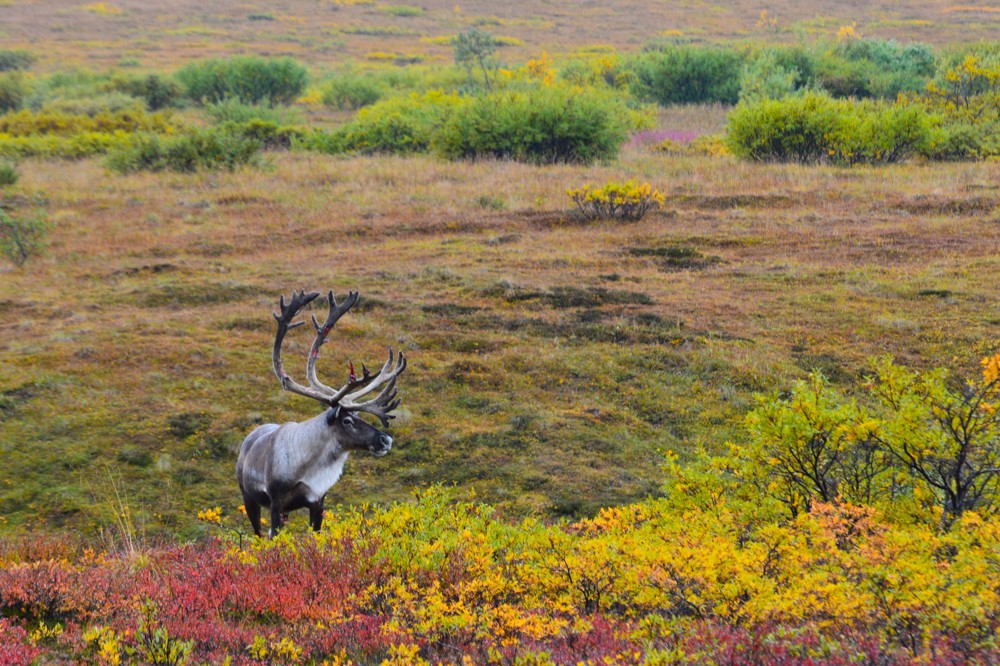
Cabin Radio: Ancient antlers show caribou calving grounds persist over millennia
UC study finds caribou have been using same Arctic areas to raise babies for 3,000 years
Cabin Radio in Canada's Northwest Territories highlighted a study by the University of Cincinnati that found caribou have been using the same Arctic calving grounds for at least 3,000 years.
UC College of Arts and Sciences paleoecologist Joshua Miller was lead author of a study published in the journal Frontiers in Ecology and Evolution that examined antlers shed by female caribou in the Arctic National Wildlife Refuge.

UC Assistant Professor of Geology Joshua Miller found that shed caribou antlers in the Arctic leave a record of historic calving grounds dating back thousands of years. Photo/Colleen Kelley/UC Marketing + Brand
Miller has been leading summer expeditions to the Arctic National Wildlife Refuge since 2010, using rafts to navigate remote rivers to search for caribou antlers exposed on the tundra.
Female caribou shed their antlers within days of giving birth, leaving behind a record of their annual travels across Alaska and Canada’s Ivvavik National Park that persists on the cold tundra for hundreds or even thousands of years. Miller and his collaborators with the University of Alaska and the U.S. Fish and Wildlife Service recovered antlers that have sat undisturbed on the arctic tundra since the Bronze Age.
The study demonstrates how important the area is for an animal that native Alaskans and Canadians still depend on for sustenance, even as energy companies seek to exploit oil and gas resources in this protected area.
Female caribou shed their antlers within days of giving birth, leaving behind a record of their annual travels across Alaska and Canada’s Yukon that persists on the cold tundra for hundreds or even thousands of years. Researchers recovered antlers that have sat undisturbed on the arctic tundra since the Bronze Age.
“It still blows my mind that you can just walk across tundra and there are these ancient echoes of this past population,” Miller told Cabin Radio.
Featured image at top: UC assistant professor Joshua Miller uses shed antlers to track the annual migration of caribou. Photo/Lucian Provines
More UC geology in the news

UC College of Arts and Sciences Assistant Professor Joshua Miller. Photo/Colleen Kelley/UC Marketing + Brand
- Billings Gazette: Old antlers help date caribou calving grounds to 3,000 years old
- Knoxville Daily Sun: Caribou have been using same Arctic calving grounds for 3,000 years
- Science Daily: Caribou have been using same calving grounds for 3,000 years
Related Stories
WVXU: UC experts discuss P&G's new green policies
September 23, 2021
UC environmental studies professors Amy Townsend-Small and Robert Hyland talk to WVXU about Procter & Gamble Co.'s new policies designed to reduce the company's carbon footprint.
Grist: UC researcher tracks down neglected methane leaks
April 8, 2021
Amy Townsend-Small is investigating long-ignored sources of greenhouse gases in the petrochemical industry.
NYT: UC professor talks about science behind mammoth study
August 13, 2021
UC associate professor Brooke Crowley talks to the New York Times about how strontium analysis allows researchers to understand how long-extinct animals lived.
Mother Jones: UC biogeochemist talks about abandoned wells
December 9, 2020
UC associate professor Amy Townsend-Small talks to Mother Jones about the growing list of oil and natural gas wells across America.
Columbus Dispatch: State investigates groundwater risks
September 8, 2020
UC associate professor Amy Townsend-Small talks about the public health risks if chemicals from injection wells migrate to groundwater.
Smithsonian: UC student interprets bison 'mummy'
November 2, 2020
UC paleoecologist Joshua Miller and doctoral student Abby Kelly talk to Smithsonian about a rare mummified steppe bison found in Alaska that could improve our understanding of life on Earth 28,000 years ago.
Billings Gazette: Feathers reveal clues to bird birthplaces
October 21, 2021
UC professor Brooke Crowley uses isotopic analysis of feathers to track the origins of wide-ranging hawks and falcons. The technique could help identify important habitat for conservation.
NPR's 1A: UC expert explains risk of leaky gas wells
October 19, 2021
UC associate professor Amy Townsend-Small explains the environmental risk of uncapped natural gas wells in Appalachia.
New York Times: Mastodon's tusks reveal life of fighting, roaming
June 27, 2022
The New York Times highlighted research by geologists and anthropologists at the University of Cincinnati who used isotopic analysis to track the seasonal migration of a mastodon across the Midwest more than 13,000 years ago.
Earth.com: Dwarf hippos in Madagascar preferred forests
July 14, 2023
Earth.com and other science media highlight UC's discoveries about extinct hippos in Madagascar. An isotopic analysis found that dwarf hippos were not grazers of grasslands but instead preferred sedges and leaves in forests. This demonstrated the importance of forests to endemic wildlife on the island.
